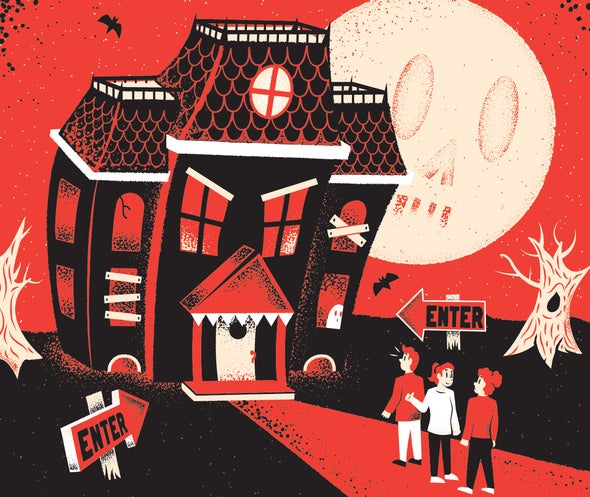From Marie Tussaud's Chamber of Horrors to Disneyland's Haunted Mansion to horror-themed escape rooms, haunted house attractions have terrified and delighted audiences around the world for more than 200 years. Today thousands of haunted houses operate in the U.S. alone.
These attractions turn out to be good places to study fear. They help scientists understand the body's response to fright and how we perceive some situations as enjoyably thrilling and others as truly terrible. One surprising finding: having friends close at hand in a haunted house might make you more jumpy, not less so.
In a 2022 study, scientists teamed up with The 17th Door, an immersive haunted experience in Fullerton, Calif. The roughly 30-minute walkthrough at The 17th Door, set in a fictitious penitentiary, has included mimicked suffocation, actual electric shocks, live cockroaches, brief submersion in water and being shot with pellets by a firing squad while blindfolded. Guests are given a safe word to exit the experience: “Mercy.”
Psychologist and study co-author Sarah Tashjian, who is now at the University of Melbourne, and her team conducted their research with 156 adults, who each wore a wireless wrist sensor during their visit. The sensor measured skin responses linked to the body's reactions to stress and other situations. When the sensor picked up, for example, greater skin conductance—that is, the degree to which the skin can transmit an electric current—that was a sign that the body was more aroused and ready for fight or flight. In addition to this measure, people reported their expected fear (on a scale of 1 to 10) before entering the haunted house and their experienced fear (on the same scale) after completing the haunt.
The scientists found that people who reported greater fear also showed heightened skin responses. Being with friends, Tashjian and her colleagues further found, increased physiological arousal during the experience, which was linked to stronger feelings of fright. In fact, the fear response was actually weaker when people went through the house in the presence of strangers.
Although Tashjian and her colleagues had initially wondered whether friends might make the experience less harrowing, she feels their study's findings also make sense. “Because the haunted house was entertaining and exciting, as well as scary, it is possible that being with people you know made the entire experience more arousing,” Tashjian explains. “There was likely a contagious feedback loop with friends that wasn't as strong among strangers.”
Other investigators have used haunted houses to understand how fear and enjoyment can coexist. In a 2020 study led by Marc Malmdorf Andersen, a member of the Recreational Fear Lab at Aarhus University in Denmark, scientists joined forces with Dystopia Haunted House. The Danish attraction includes such terrifying experiences as being chased by “Mr. Piggy,” a large, chain-saw-wielding man wearing a bloody butcher's apron and pig mask. People between the ages of 12 and 57 were video recorded at peak moments during the attraction, wore heart-rate monitors throughout and reported on their experience. People's fright was tied to large-scale heart-rate fluctuations; their enjoyment was linked to small-scale ones. The results suggest that fear and enjoyment can happen together when physiological arousal is balanced “just right.”
An earlier study led by Mathias Clasen of Aarhus University also used Dystopia Haunted House to gain insight into how “adrenaline junkies” and “white-knucklers” manage their fear. Some visitors applied strategies to minimize fear, such as closing their eyes. Others sought out scary stimuli to maximize terror. Both groups reported similar levels of satisfaction, suggesting that people upregulate and downregulate their fear arousal for an optimal experience.
Understanding these patterns has real-world benefits. Tashjian notes that learning what factors amplify and reduce threat responses can help people with post-traumatic stress disorder or anxiety. She adds that you can help to consciously regulate your body's fear response “by practicing deep-breathing exercises or meditation [and] mindfulness.” These practices can benefit many people facing stressful or threatening experiences in day-to-day life.
But in the meantime, if you want to get really scared at your next haunted house, keep your eyes open, lean into the scary moments—and bring some friends along.
Are you a scientist who specializes in neuroscience, cognitive science or psychology? And have you read a recent peer-reviewed paper that you would like to write about for Mind Matters? Please send suggestions to Scientific American’s Mind Matters editor Daisy Yuhas at pitchmindmatters@gmail.com.
This is an opinion and analysis article, and the views expressed by the author or authors are not necessarily those of Scientific American.



